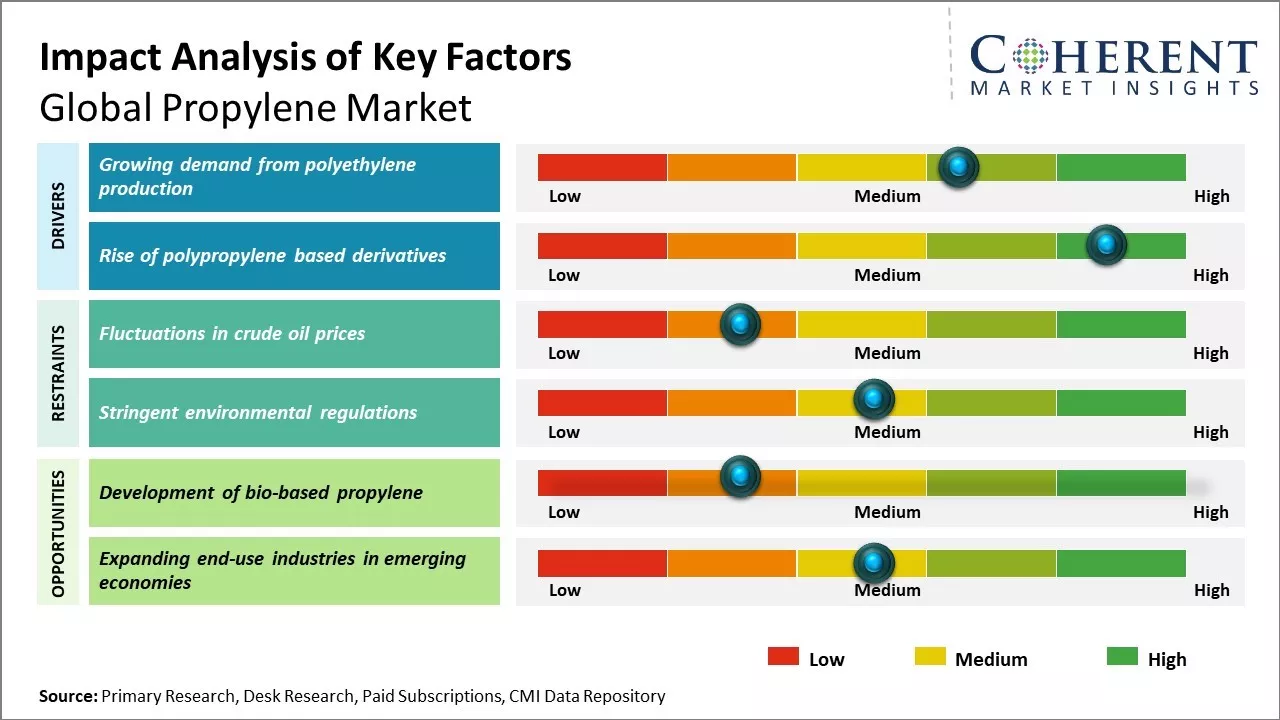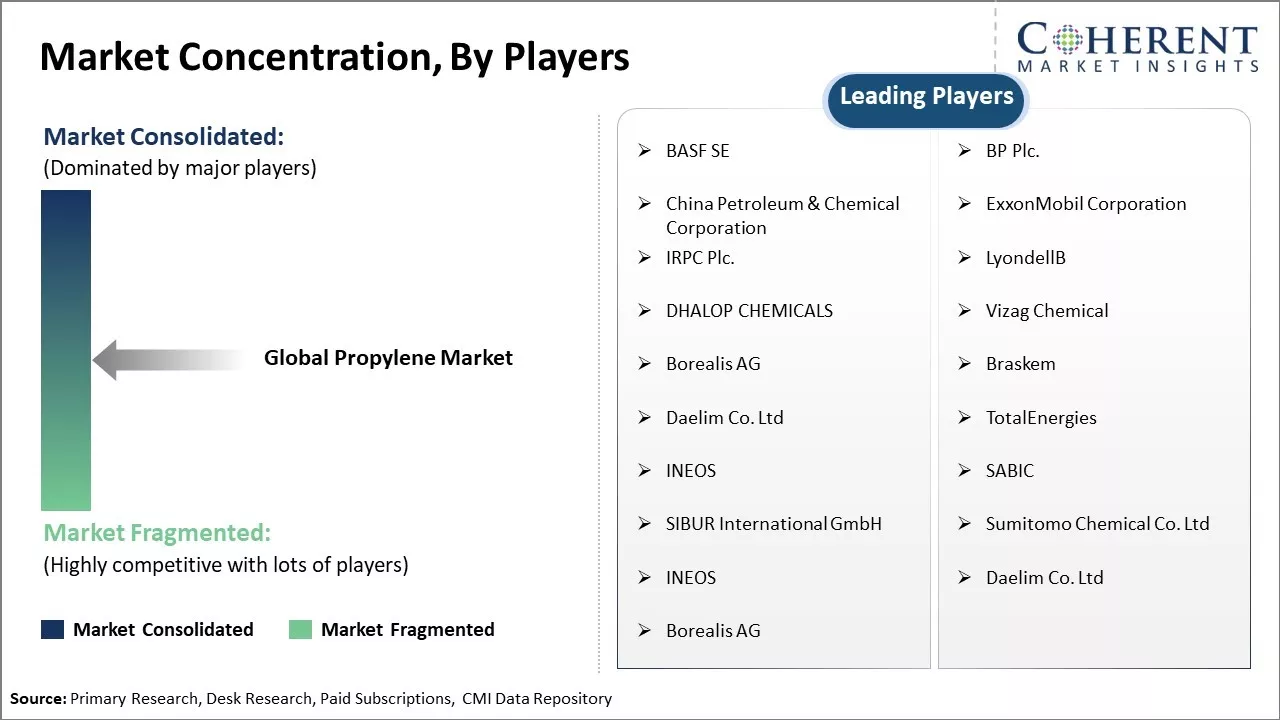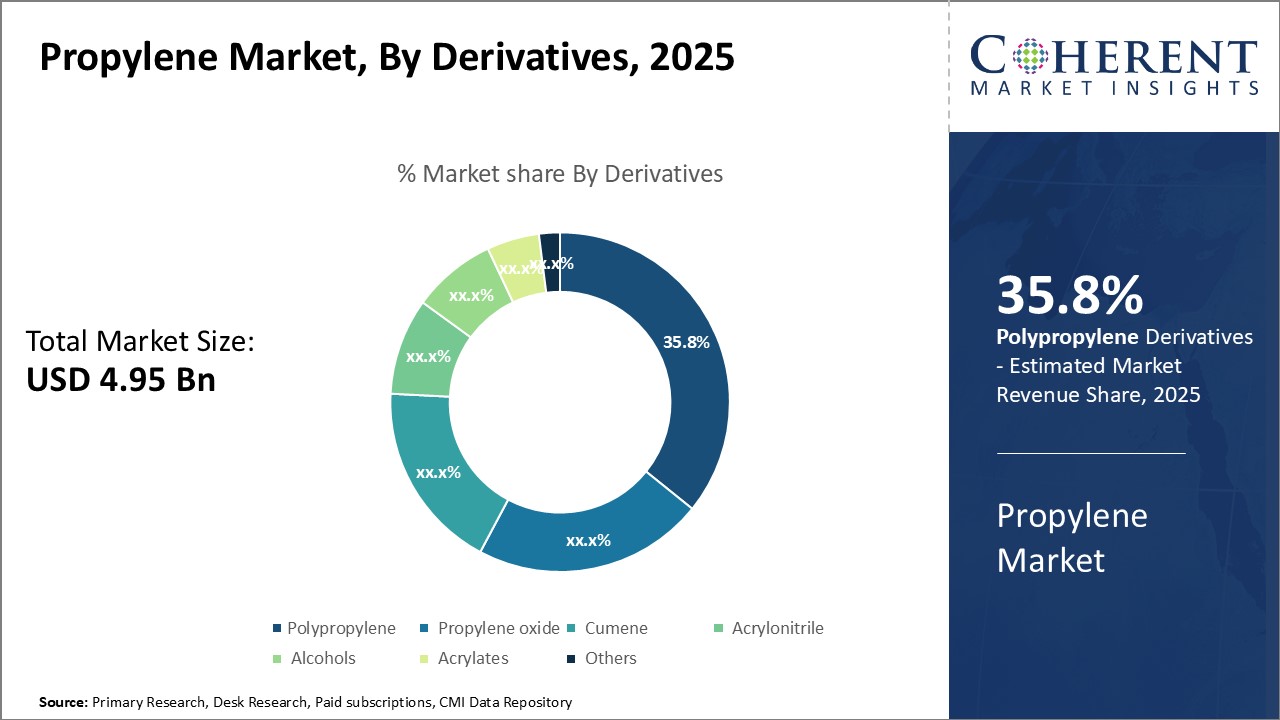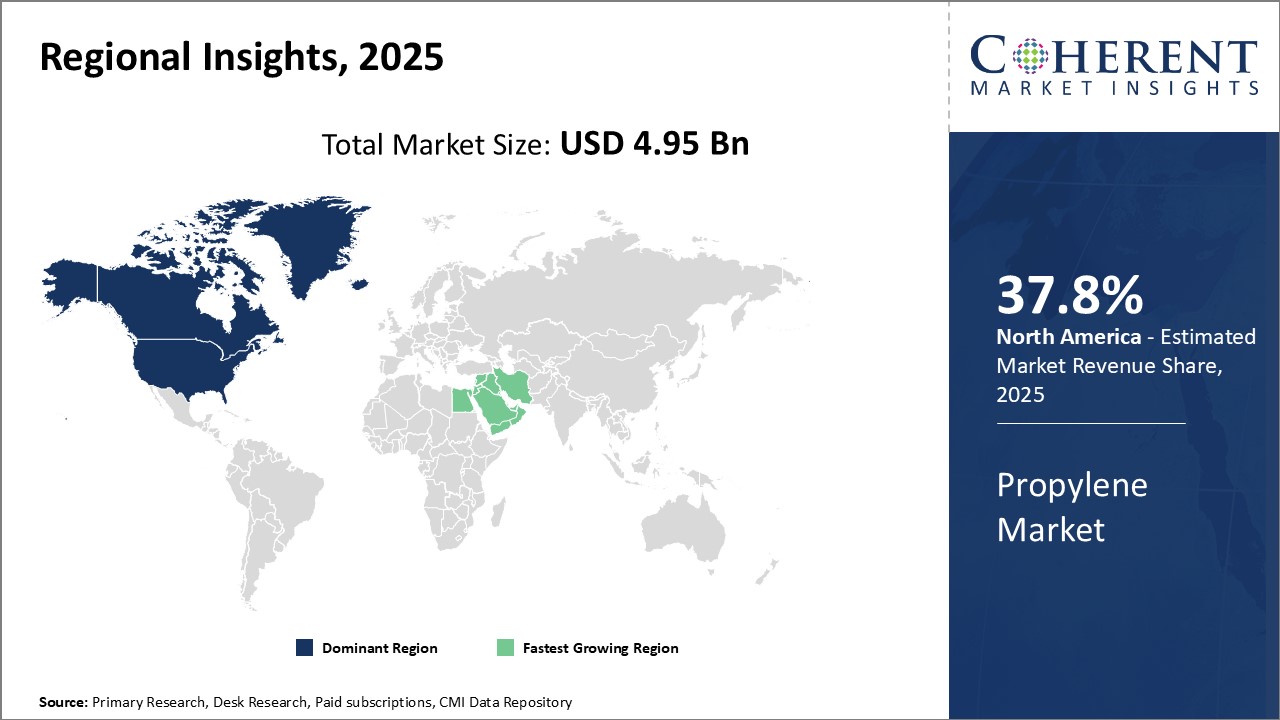The propylene market is estimated to be valued at USD 4.95 Bn in 2025 and is expected to reach USD 7.60 Bn by 2032, exhibiting a compound annual growth rate (CAGR) of 6.3% from 2025 to 2032.

Discover market dynamics shaping the industry: Download Free Sample
The demand for propylene is expected to grow steadily during the forecast period. It is primarily driven by the growth of the petrochemical industry and increasing demand from the polypropylene sector. Propylene is a basic petrochemical used to produce polypropylene, which is used widely in the packaging, consumer products, and automotive industries. As the spending power increases globally, the growth in the automotive and packaging industries will positively influence the propylene market. Also, the increasing penetration of polypropylene in emerging applications such as medical devices, construction, and agriculture will support the demand for propylene during the forecast years.
Growing demand from polyethylene production
The primary driver for growth in the propylene market is the increasing demand from polyethylene production. Polyethylene finds wide ranging uses from the packaging industry to construction materials. Low density polyethylene (LDPE) and linear low density polyethylene (LLDPE) are the major polyethylene resins which use propylene as the raw material. With the rising global consumption of plastic, the production of polyethylene is witnessing significant expansion especially in emerging economies. Polyethylene resins are increasingly replacing traditional materials in various end-use industries due to their advantages such as durability, flexibility, and lightweight properties. The food packaging market has exhibited formidable growth fueled by changing lifestyle, demand for convenient packaging, and ready-to-eat foods. Other applications such as non-food packaging, plastic bags, films, and containers have proliferated with growth in the e-commerce and personal care sectors. The consumer products industry too utilizes polyethylene compounds for durable goods, toys, and stationery items. Building and construction is another important segment driving the polyethylene demand globally. LDPE and LLDPE resins provide excellent insulation and waterproofing properties making them ideal for usage as vapor barriers, roofing sheets, and pipes. Their corrosion resistance and strength make them suitable substitutes for traditional materials in infrastructure projects. Expanding global construction industry in sync with rapid urbanization is a major factor augmenting the volumes of polyethylene consumed.

Get actionable strategies to beat competition: Download Free Sample
Rise of polypropylene based derivatives
A major driver accelerating propylene consumption is the rise of polypropylene-based downstream products. Polypropylene (PP) is synthesized from propylene and finds extensive applications across industries. The global polypropylene capacity has been significantly enhanced over the years to cater to the growing needs of various. PP possesses characteristics such as durability, heat resistance, corrosion protection, and flexibility which makes it appropriate for diverse applications. The automotive industry has emerged as a prominent consumer of polypropylene compounds. Different interior and exterior automotive parts such as seat belts, airbags, bumpers, instrument panels, side panels, and spoilers incorporate PP for its properties like lightweight, thermal stability, and durability. Appliance manufacturers also depend on PP for water supply pipes, dispenser components, home care product containers, and wire and cables coating.
Key Takeaways of Analyst:
The propylene market is expected to experience steady growth in the coming years driven by increasing demand from polypropylene applications. Asia Pacific currently dominates the market and is predicted to maintain its leading position throughout the forecast period supported by rapid industrialization and infrastructure development in China and India.
Propylene production is forecast to rise modestly to meet the needs of polypropylene used extensively in packaging, automotive, and construction industries globally. However, overcapacity scenarios and fluctuations in crude oil prices may challenge petrochemical margins and dampen capacity additions.
Alternatives such as bio-based propylene can provide opportunities for market participants but high production costs remain a major constraint. Adoption of propylene derivatives may strengthen further for applications like medical devices, electronics, and textiles. Nevertheless, an economic downturn could impact downstream polypropylene consumption and curb volume gains. Stricter environmental regulations pose another threat as they heighten compliance expenses for producers. The market is rather consolidated with key players focusing on integrating operations and expanding trade networks.
Market Challenges: Fluctuations in crude oil prices
Fluctuations in crude oil prices have played a major role in restraining the growth of the global propylene market in recent years. Propylene is primarily produced through the steam cracking process, where petroleum liquids and natural gas liquids rich in hydrocarbons are separated through heating in the presence of steam. As crude oil and natural gas are the major feedstock required for steam cracking, volatile crude oil prices directly impact the feedstock costs and overall economics of propylene production.
Market Opportunities: Development of bio-based propylene
Development of bio-based propylene has the potential to provide significant opportunities in the global propylene market going forward. As awareness around sustainability and reducing reliance on fossil fuel-based products grows worldwide, the demand for bio-based and renewable feedstocks is increasing rapidly across various industries. Propylene is a key petrochemical used in the production of several essential plastic and chemical products. Currently, nearly all of the global propylene supply is met through oil refineries. However, with depleting petroleum reserves and rising environmental concerns, bio-based alternatives are being explored as a more sustainable solution for long-term security of propylene supply. Several companies and research organizations are actively working on developing technologies to produce propylene at a commercial scale using renewable biomass sources like sugar cane, corn, agricultural residues, and wood as feedstock. Some of the bio-refining pathways under investigation include producing propylene through fermentation of biomass-derived sugars or thermochemical conversion via gasification. For example, firms like Global Bioenergies in France have demonstrated the production of bio-based propylene through fermentation at pilot plant scale successfully. There are also ongoing projects to genetically modify certain microorganisms to directly produce propylene instead of ethanol. If these bio-based production routes can be optimized and costs reduced through innovation, it could displace a significant portion of fossil-based propylene consumption in the future.

Discover high revenue pocket segments and roadmap to it: Download Free Sample
Insights, by Derivatives: Diverse applications
In terms of derivatives, polypropylene is expected to contribute 35.8% share of the market in 2025. Polypropylene (PP) contributes the largest share among propylene derivatives owing to its wide range of applications across industries. PP possesses desirable properties such as lightweight, resistance to corrosion, and durability which has led to its increasing adoption in the packaging industry. Propylene-based packaging solutions like flexible films and bags provide an excellent barrier against moisture, grease and oils, making them ideal for food packaging. PP is also commonly used for plastic containers, lids and bottles. The lightweight and shatter-resistant qualities of PP make it suitable for packaging beverages, personal care and household products. Apart from packaging, another major end-use sector driving PP demand is the automotive industry. Polypropylene composites are extensively utilized in manufacturing automotive components such as seats, consoles, door panels, bumpers, and grills owing to properties like high impact strength and flexibility. The use of PP over conventional steel or aluminum results in reduced weight of vehicles, thereby improving fuel efficiency. PP is also valued in construction applications due to its ability to withstand exposure to sunlight and weathering. Propylene-based materials are commonly used for roofing, siding, pipes, insulation and deck rails. Cumene, a valued by-product derived from propylene, also sustains substantial demand growth. Cumene serves as a key feedstock in production of phenol and acetone which have widespread industrial usage. Phenol finds employment in manufacturing resins, adhesives and coatings through products such as bisphenol A and phenol-formaldehyde resins. Acetone is utilized as a solvent in paints, coatings, lacquers and cleaners. Reliable supply of propylene aids in meeting the requirements of cumene-based derivatives industry. Steady growth of end-use industries thus acts as a central driver boosting propylene derivative polypropylene sales.
Insights, by End-use Industry: Rising vehicle production
In terms of end-use industry, automotive is expected to contribute 35% share of the market in 2025. The automotive industry single-handedly absorbs the largest proportion of propylene supply owing to wider employment of propylene-based plastics in vehicles. Propylene plastic composites like polypropylene, propylene oxide, and acrylonitrile along with engineering thermoplastic elastomers find extensive employment in automobile manufacturing. Properties such as high impact strength, flexibility and resistance to heat, abrasion, and chemicals make propylene-derived polymers suitable substitutes for traditional materials like steel and aluminum. Rising vehicle ownership, facilitated by increasing disposable incomes as well as availability of financing options, has augmented global automotive production volumes significantly. The propylene market growth is lifted by the relentless demand from automakers to incorporate more lightweight and durable plastic components in vehicles. Additionally, implementation of stringent fuel efficiency mandates in major automotive markets promotes the use of plastic over metal to help reduce vehicle weight and curb emissions. Propylene polymers also serve as recyclable, affordable alternatives to meet sustainability targets set by regulatory bodies and automakers themselves. Apart from new vehicle manufacturing, growth in the aftermarket sector also spurs the propylene consumption. Plastic parts experiencing wear and damage need frequent replacement, ensuring continued demand. Population expansion in developing regions is translating to higher car ownership rates, propelling the automotive industry's requirements for propylene and derivatives. This substantiates automotive industry's position as the dominant end-use driving the propylene market.

Need a Different Region or Segment? Download Free Sample
North America has established itself as the dominant region in the global propylene market. The region is expected to account for 37.8% of the market share in 2025, owing to robust industrial presence and mature demand from well-established end-use industries. The U.S., in particular, accounts for the largest share of the regional propylene demand on the back of a booming petrochemical industry and strong consumption from major derivate industries like polypropylene, acrylonitrile, and propylene oxide. With annual capacity additions and expansions at propylene crackers on the Gulf Coast, North America has reliable supply infrastructure to cater to growing needs. Additionally, the regional market benefits from easy access to competitive feedstock supplies of propane, butane, and ethane produced alongside oil and gas extraction activities. This has supported healthy margins for North American propylene producers over the years. Regional players have also established long-term offtake agreements with major domestic consumers to secure downstream demand. However, North American players are increasingly facing competitive pressures from cheaper international exports, particularly from the Middle East. New propylene capacities coming online globally may gradually reduce North America’s overall dominance.
The Asia Pacific region has emerged as the fastest growing market for propylene globally over the past decade led by China and India. Robust industrial and infrastructure growth coupled with a steadily rising population has driven massive gains in key derivate industries that consume propylene such as polypropylene, cumene. Major capacity additions are ongoing to cater to this sustained domestic demand growth. Countries like China and India additionally benefit from abundant reserves of natural gas, which is an important feedstock for cost-competitive propylene production. Several players have announced capacity expansion projects along the coastlines to facilitate easy import and export logistics. Rapid urbanization and rising disposable incomes are also supporting the increased consumption of consumer goods and durable items that use propylene-based materials. The increasingly globally integrated nature of value chains across Asia Pacific has made the region an export and import hub in the global petrochemical trade flow. This positions Asia Pacific as an integral market for propylene producers and consumers worldwide going forward.
Propylene Market Report Coverage
| Report Coverage | Details | ||
|---|---|---|---|
| Base Year: | 2024 | Market Size in 2025: | USD 4.95 Bn |
| Historical Data for: | 2020 To 2024 | Forecast Period: | 2025 To 2032 |
| Forecast Period 2025 to 2032 CAGR: | 6.3% | 2032 Value Projection: | USD 7.60 Bn |
| Geographies covered: |
|
||
| Segments covered: |
|
||
| Companies covered: |
BASF SE, BP Plc., China Petroleum & Chemical Corporation, ExxonMobil Corporation, IRPC Plc., LyondellB, DHALOP CHEMICALS, Vizag Chemical, Borealis AG, Braskem, Daelim Co. Ltd, TotalEnergies, INEOS, SABIC, SIBUR International GmbH, Sumitomo Chemical Co. Ltd, INEOS, Daelim Co. Ltd, and Borealis AG |
||
| Growth Drivers: |
|
||
| Restraints & Challenges: |
|
||
Uncover macros and micros vetted on 75+ parameters: Get instant access to report
Share
Share
About Author
Vidyesh Swar is a seasoned Consultant with a diverse background in market research and business consulting. With over 6 years of experience, Vidyesh has established a strong reputation for his proficiency in market estimations, supplier landscape analysis, and market share assessments for tailored research solution. Using his deep industry knowledge and analytical skills, he provides valuable insights and strategic recommendations, enabling clients to make informed decisions and navigate complex business landscapes.
Missing comfort of reading report in your local language? Find your preferred language :
Transform your Strategy with Exclusive Trending Reports :
Frequently Asked Questions
Joining thousands of companies around the world committed to making the Excellent Business Solutions.
View All Our Clients